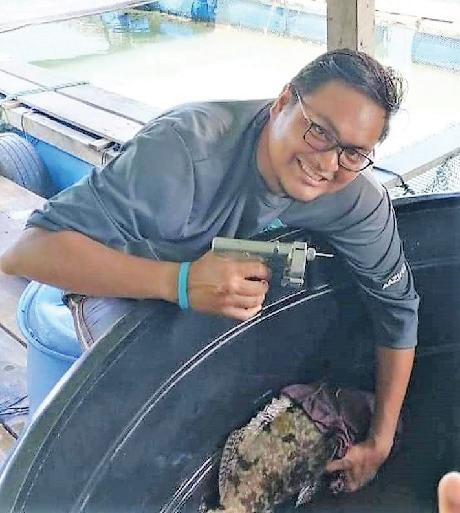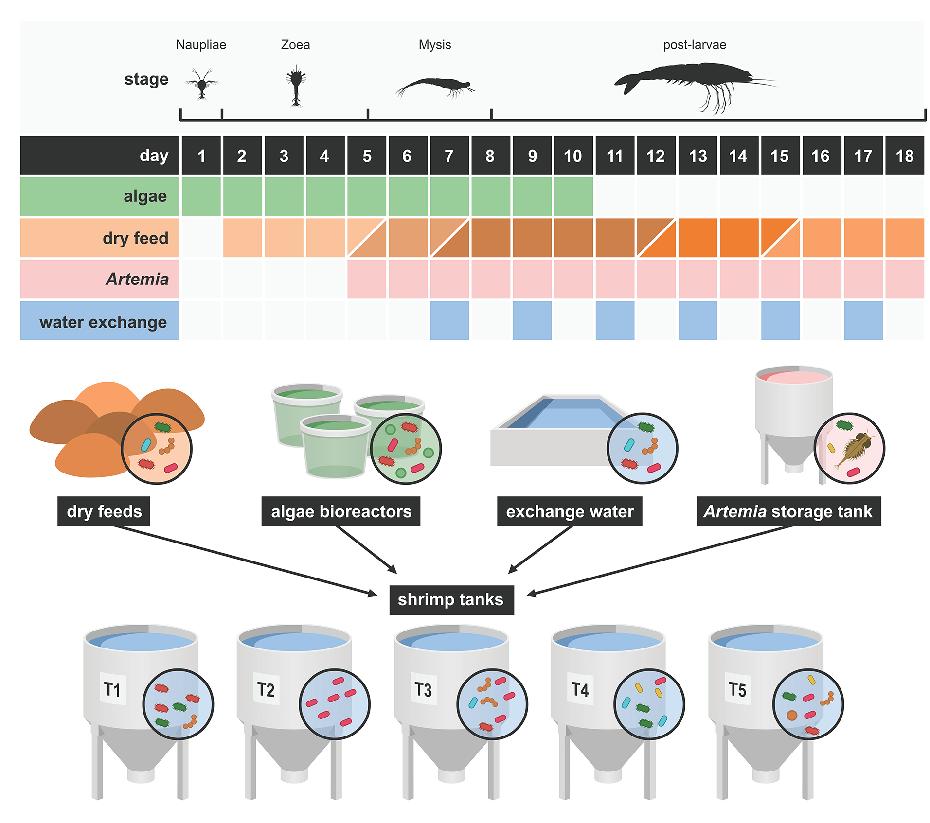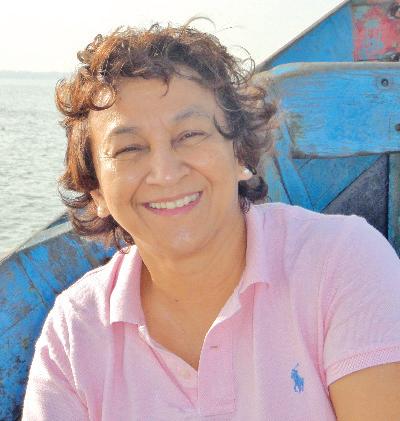
26 minute read
them
A high-density multispecies fish culture approach for enhancing marine fish production in India.
Advertisement
By Sekar Megarajan, Ritesh Ranjan, Biji Xavier, Ponnaganti Shiva, Shubhadeep Ghosh and Boby Ignatius
Pompano are harvested when fish reach 700g after a grow-out duration of 210 days. In this integrated cage -cum-pond system, it is possible to partially harvest fish from the cages. The market price of pompano was INR330/kg in February 2021
Aquaculture continues to play an important role in meeting an ever-increasing demand for fish globally. This is more so in India where the population is projected to rise to 1.65 billion by 2050. It has been estimated that India must produce nearly 10.5 million tonnes of fish annually to meet the requirement of this growing population. Most of this is expected to be from freshwater fish aquaculture. However, a significant contribution from mariculture/ coastal aquaculture is essential, to complement the annual supply from capture fisheries which has stagnated at 3.54.0 million tonnes.
In recent years, India has become a leader in coastal aquaculture production, but this is solely dominated by the marine shrimp sector. On the other hand, India is still at the initial stage in marine finfish aquaculture production. Today, the contribution of marine aquaculture to national fish production is insignificant. There is scope for mariculture development in India through the efficient use of technologies, resources and species available in the country. To meet the demand for domestic consumption, a sustainable development of the sector is essential.
Farming the pompano in India
Species diversification is one of the major approaches adopted to increase fish supply from aquaculture. A suitable marine finfish candidate is the pompano Trachinotus spp, in the family Carangidae. The pompano, with the following characteristics is the preferred species for mariculture: ease of breeding in controlled condition; quick adaptability to different culture conditions; tolerant to a wide range of salinity; fast growth rate; pleasant appearance; good meat quality and high consumer preference. Unlike some of the other cultured marine fishes, the pompano is quick to readily accept artificial pelleted feed and can complete their entire culture cycle solely with artificial feeds.
At the Central Marine Fisheries Research Institute (CMFRI), under Indian Council of Agriculture Research (ICAR), researchers have succeeded in breeding two species of pompano and produced a consistent seed supply. The breakthrough for the Snubnose pompano (Trachinotus blochii) was in 2010, while that for the Indian pompano (Trachinotus mookalee) was in 2016.
Culture technology for these species was subsequently standardised in different culture systems such as coastal ponds and sea cages in different locations. Results have been very encouraging. Thereafter, these culture methods were demonstrated in different parts of the country under different research programmes by ICAR – CMFRI, and with financial support from the National Fisheries Development Board (NFDB), Government of India. The demonstration and dissemination of technology have created awareness among different aquaculture farmers and have convinced them to venture into pompano farming.
Integrated culture systems
Several culture methods have been used for marine finfish production, including pond culture, recirculating aquaculture system (RAS), in-pond raceway recirculating (IPRS) culture systems and cage culture (Wang et al., 2020). Pond-based culture has a low stocking density of 1 fish/m2, whereas other methods use a high stocking density of 15-30 fish/m3 of water body. The challenges with the high stocking density culture systems include high cost of production and dependency on skilled manpower.
Therefore, we have investigated alternative aquaculture production systems for finfish, to target efficient land utilisation and high productivity. One such alternative is the integrated cage-cum-pond culture culture system where fish are cultured in cages in cages that are integrated with semi-intensive culture of other or same fish species in open ponds (Sipauba-Tavers et al., 2016). Fish in cages are fed a complete feed, while the same species or other low value fish stocked in the open pond are fed at low feed frequency or depend only on the natural food in the pond. The pond reared fish derive nutrients from uneaten foods from the cages or from autotrophic and heterotrophic food chains.
In this farming method, there is a high stocking density for fish in cages located in ponds and a low stocking density for the fish in the open area of the ponds. The total production efficiency increases 3-4 times, compared to the fish cultured in open pond alone. This culture system has been mainly practised for freshwater fish at a high stocking density of up to 100 fish/m3. A maximum production of 24kg/m3 was achieved by utilising 20% of the pond area for cage culture (Quagrainie et al., 2011). However, this culture method has not been adopted well for marine finfish culture, as most of the marine fish species are being cultured in cages in open waters.
Integrated cage-cum-pond system
To evaluate the feasibilities of this culture method for marine finfish, a study was conducted for Indian pompano T. mookalee under an integrated culture system in coastal ponds by ICAR-CMFRI, Visakhapatnam Regional Centre in different locations in the Andhra Pradesh state. The result of the study was promising. The Indian pompano juveniles produced at the mariculture hatchery, Visakhapatnam Regional Centre of ICAR-CMFRI was stocked at a high density of 15 fish/m3 in a net cage of 8 X 8 X 1.5m. The stocking density was reduced to 10 fish/ m3 after reaching 250g size. A total of four cages were created in the pond and these cage structures occupied less than 15% of the pond area. At the same time, the same fish species were also stocked in the open pond at a low stocking density of 0.25 fish/ m3 (Sekar et al., 2020). The Indian pompano stocked in the integrated cages and open pond were fed with pelleted feed with 40% of crude protein and 10% of crude fat (Growel Feeds Pvt Ltd, India).
After one year of grow-out culture, the fish in the net cages had reached the size of 880g, whereas the same fish stocked at low stocking density in the open pond had reached the size of 695g during the same period. The result showed that the fish cultured in cages grew 31% faster than the fish stocked in the open pond at low stocking density. Pompano is harvested when fish reach 710g after a growout duration of 210 days. In this integrated cage-cum-pond system, it is possible to partially harvest fish from the cages. The market price of pompano was INR330/kg (USD 4.7/kg) in February 2021. Thus, this method provides farmers with an opportunity to use their limited pond resources to increase fish yield and generate more income. The information gained from these preliminary studies suggested that the pompano is a potential candidate for culture under integrated cagecum-pond culture methods.

Culture of the Indian pompano (Trachinotus mookalee) in integrated cage cum pond system. Cages are placed in 1ha ponds and fish in the cages are fed with 40% crude protein diets.
Prospects and opportunities for integrated marine finfish culture in India
Aquaculture is expanding in India in different ways. There is a variety of production systems but ponds are currently the most common. This integrated cage-cum-pond system allows for the use of an existing pond without further modifications. If water quality is managed well, this method would yield 2-3 times more production than if the same pond is used for fish culture without integration.
In India, marine shrimp culture is one of the fastest-growing farming systems, using a culture area of 93,496ha during 2017-2018. However, at the same time primarily, because of disease related setbacks, shrimp farmers had suffered frequent losses (Kalaimani et al., 2013). Some farmers are opting for alternative farming methods, which produce profits similar to shrimp farming. In this context, we think that introducing high-density culture of pompano and integrating it with other species will play an important role. It can be an alternative for existing shrimp farmers where intercropping with finfish can be the best option to break the chain of disease-causing pathogens.
It has been estimated that about 1.2 million ha of potential brackish water are available for fish culture in India. Only 10% of this area has been utilised. Thus, a large area is still available for pond-based marine fish culture. Moreover, the culture technologies for milkfish (Chanos chanos) and grey mullet (Mugil cephalus) are well established in India and widely adopted by farmers. Being euryhaline in nature, these species could also be cultured in saline ponds fed with low protein feeds. A high-density culture of pompano in integrated cages fed with high protein feed combined with milkfish or mullet in the open pond fed with low protein feed could effectively utilise the pond space as well as avoid feed wastage.
Conclusion
We envisage that an estimated production of 5 million tonnes of marine fish could be achieved via aquaculture by 2050 to meet India’s fish demand. At the same time, the government has been focusing on doubling farmer’s income
An integrated cage-cum-pond system experiment conducted by ICAR-CMFRI, Visakhapatnam Regional Centre in coastal ponds at Bhavedevarapalli, Krishna District, Andhra Pradesh, India.
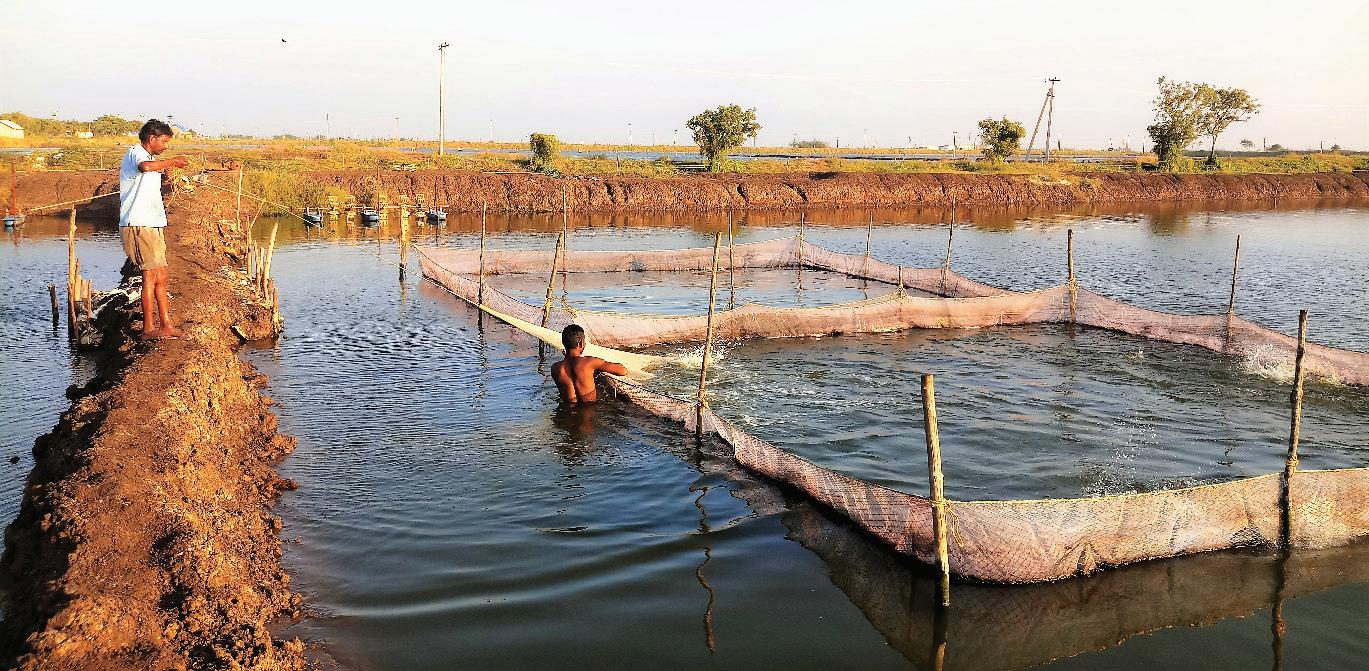
through various means. Thus, introducing new culture methods in addition to the existing cage and pond-based culture systems can help to achieve the government’s goal. This integrated cage-cum-pond culture method would be one of the approaches for increasing fish production and doubling farmer’s income by effective utilisation of culture area.
References
Sekar, M., Ranjan, R., Xavier, B., Ghosh, S., Shiva, P., Sadu, N. and Ignatius. 2020. Comparative growth and biochemical responses of Indian pompano (Trachinotus mookalee) cultured in integrated cage cum pond and pond culture systems. RSAEP-10. MECOS 7-10 January 2020. Kochi, Kerala, India. Sipaúba-Tavares, L.H., Rodrigo Ney Millan, R.N., Ana Milstein, A. 2016.Limnology of an integrated cage-pond aquaculture farm. Acta Limnol. Bras. vol.28 Rio Claro. http://dx.doi.org/10.1590/ S2179-975X3014 Quagrainie, K., Nguig, C.C., Macharia, S., Mwihaki, K.G. 2012. Assessment of Integrated Pond-Cage System for the Production of Nile Tilapia for Improved Livelihood of Small-Scale Fish Farmers in Kenya. Technical Reports: Investigations, 2009 - 2011. 182-194. Wang, Y., Xu, P., Nie, Z., Li, Q., Shao, N., Gao, J. and Xu, G. (2020), Effects of Feeding Rates on Growth, Digestive Enzyme Activity, Serum Biochemical Parameters, and Body Composition of Juvenile, Genetically Improved, Farmed Nile Tilapia Reared in an In-Pond Raceway Recirculating Culture System. North Am J Aquaculture, 82: 75-83. https://doi.org/10.1002/naaq.10124
Dr Sekar Megarajan, Dr Ritesh Ranjan, Dr Biji Xavier,
Dr Ponnaganti Shiva and Dr Shubhadeep Ghosh are with ICAR-Central Marine Fisheries Research Institute, Visakhapatnam Regional Centre, Andhra Pradesh, India. Emai: sekarrajaqua@gmail.com
Boby Ignatius is with ICAR-Central Marine Fisheries Research Institute, Kochin, Kerala, India.
May/June 2021
Issue focus: Demand and Supply Equilibrium Industry review: Aquafeed Production Feed/Production Technology: Extrusion & Pelleting/Hatchery Technology
Deadlines: Articles – March 12/Adverts –March 19
July/August 2021
Issue focus: Sustainable & Responsible Aquaculture Industry review: Tilapia Feed/Production Technology: Sustainable Feeds/ Big Data
Deadlines: Articles – May 14/Adverts –May 21
A strategic partnership to develop the aquafeed business in Vietnam
Viet Uc AquaFeed Company Limited in Ben Tre Province.

In early March, BioMar took another important step to expand its global footprint within the shrimp feed business. It has acquired a majority ownership of the VietUc feed business and is ready to pursue a position within high-end shrimp feed in Vietnam. This creates a synergy with its existing shrimp businesses in Latin America.
After a comprehensive due diligence, BioMar and VietUc have signed an agreement for BioMar to acquire the majority of the Viet-Uc feed business. Through this acquisition BioMar establishes a partnership together with one of the leading seafood groups in Vietnam active in shrimp hatcheries, fish hatcheries and shrimp farming. The ambition is to grow the market for high-end feed products focusing on sustainability, traceability, quality, and performance. The acquisition is subject to customary approvals by the authorities.
“With this partnership we open an important door into the Vietnamese market, one of the world’s leading shrimp producing countries with a production close to 500,000 tonnes of shrimp. Considering the performance and agility of the Vietnamese shrimp industry during the last decade and not at least during this last year of pandemic, I am sure the market holds a great potential for growth.” explains Carlos Diaz, CEO, BioMar Group.

Looking at market forecasts and the increasing consumer focus on healthy and sustainable seafood, BioMar expects there will be an increasing market share for high-end feed, ensuring customers can capture value by delivering certified and tailored products towards global retail channels. Building upon its business model of promoting local market agility in combination with global excellence, the company will shortly be able to turn research and knowledge within shrimp feed into new product and service offerings to the Vietnamese market.
“BioMar is already a significant shrimp feed producer in South and Central America and it is our ambition to continue the journey to become a major player within high-end shrimp feed. Within the past 5 years, we have established a significant production of shrimp feed in Ecuador and Costa Rica in partnership with large-scale local farmers. Now, adding Vietnam into the equation will enable us to build a strong relationship both to the market in Vietnam but also to the nearby countries, and at the same time creating benefits from the relation between genetic and nutritional development. Partnering with one of the leading companies within this field in order to develop high performance feeds, concepts and value chain collaborations makes a lot of sense in order to promote a positive development of the shrimp industry “, concludes Carlos Diaz.
Since 2012, BioMar has been engaged in the development of feed and technical services for shrimp utilizing the capabilities of global R&D in combination with trial facilities around the world, most recently through the advanced internal feed trial unit in Ecuador dedicated to shrimp and local trials in Vietnam. Moving into Asia will strengthen the position of BioMar in the global shrimp industry and make it possible to share know how and best practice across the continents.
At a Viet Uc’s superintensive greenhouse shrimp farming facility. From left, Tuan Quoc Tran, Viet Uc; Carlos Diaz and Michael Gammelgaard, Director, Global Business Development, BioMar.
Breaking ground for a new €24 million aquafeed mill in Vietnam
Skretting has announced its plan to construct a new factory in 2021 as part of its commitment to aquaculture in Vietnam and the broader southeast Asia region. The new factory will supply the growing market with an annual capacity of 100,000 tonnes.
Reflecting an investment of €24 million, the state-ofthe-art facility will enable effective feed supply to key farming provinces in the Mekong Delta and beyond. With existing facilities at full capacity, the new factory will alleviate the current demand on supply. The new factory is located next to Skretting Vietnam’s existing facilities in Thuan Dao Industrial Zone, Long An.
“With a mission and commitment of bringing good solutions to farmers and contributing to the sustainable development of aquaculture in Vietnam, Skretting Vietnam is dedicated to leveraging our global resources to offer a complete value proposition for our customers,” said Bui Thuy Tien, General Manager of Skretting Vietnam.
Vietnam became part of the Skretting family in 2010
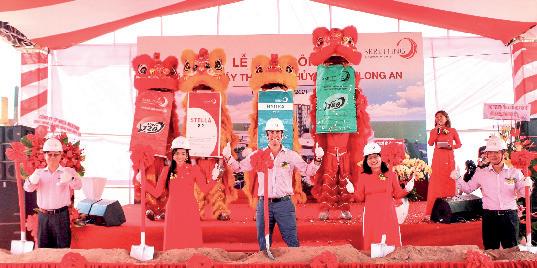
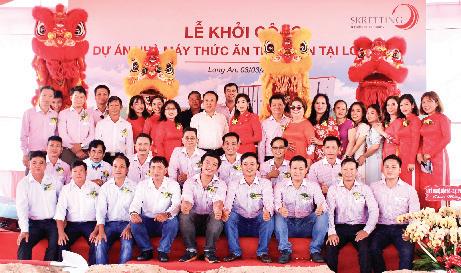
Leading animal nutrition and feed additive firm BIOMIN has launched its newest mycotoxin risk management solution in selected markets across the Asia Pacific region. Mycofix Plus 5.Z with ZENzyme is an innovative, all-in-one feed additive providing next-generation mycotoxin risk management for breeding animals and their offspring. ZENzyme is the first and only purified enzyme that degrades zearalenone (ZEN) fast, specifically and irreversibly into non-toxic and nonestrogenic metabolites.
“With the introduction of ZENzyme into the Mycofix range, we raise the bar once again in terms of state-of-the-art protection against mycotoxins for our customers,” noted Ursula Hofstetter, Head of Global Product Management Mycotoxins at Biomin.
“ZENzyme offers the animal protein sector full and complete protection against zearalenone. With consistent and proper application, farmers will have the confidence that their animals will not face ZENinduced reproduction or health challenges,” added Franz Waxenecker, Managing Director.
Zearalenone, a naturally-occurring toxin produced by fungi, commonly contaminates crops including corn (maize), wheat and soy at potentially harmful levels according to the Biomin Mycotoxin Survey. Binders are not sufficient against zearalenone and other techniques are needed. Therefore, Biomin has pioneered the field through the acquisition of Tomboy Aquafeed JSC, a reputable Vietnamese fish and shrimp feed company. In the ten years since, Skretting Vietnam has fully embedded the Skretting culture into all of its operations – from research and raw material procurement to products and services for aquaculture. The latest shrimp feed factory opened in 2017.
“This new factory in Vietnam is a logical and necessary step towards strengthening Skretting and Nutreco’s position as a global competitor in Asia,” said Therese Log Bergjord, Skretting CEO. “We have a very solid growth strategy, matched with the huge potential of the sector. We have activated an expert team to make sure we deliver, and I’m excited to see how we continue to grow in the coming years.” www.skretting.com
of mycotoxin mitigation using enzymatic biotransformation, beginning with the introduction of FUMzyme —the world’s first-ever commercially available mycotoxin-deactivating enzyme that degrades fumonisins in 2013.
Enzymatic biotransformation involves enzymes designed to specifically target a mycotoxin and detoxify the fungal metabolite irreversibly, thus protecting animals from potential harm. The Mycofix range of feed additives is the only mycotoxin solution on the market that includes purified mycotoxindegrading enzymes, namely: FUMzyme and ZENzyme, as well as a mycotoxindegrading microorganism, BBSH® 797, for the degradation of trichothecene mycotoxins.
“Over the years we have invested considerably in technologies to counteract mycotoxins, and many of these novel technologies have achieved EU authorizations for their scientifically proven safety and efficacy,” explained Hofstetter. “While we have had some success in counteracting zearalenone in the past, ZENzyme is quite simply faster and better than any other technology available.”
In aquaculture, zearalenone is known to have several negative consequences for fish and shrimp, including reduction in broodstock productivity, reduction in offspring survival, increased rate of mutations and malformations, effects on gonads and roe. www.biomin.net
Ursula Hofstetter is Head of Global Product Management Mycotoxins at Biomin
Startup networking in Indonesia
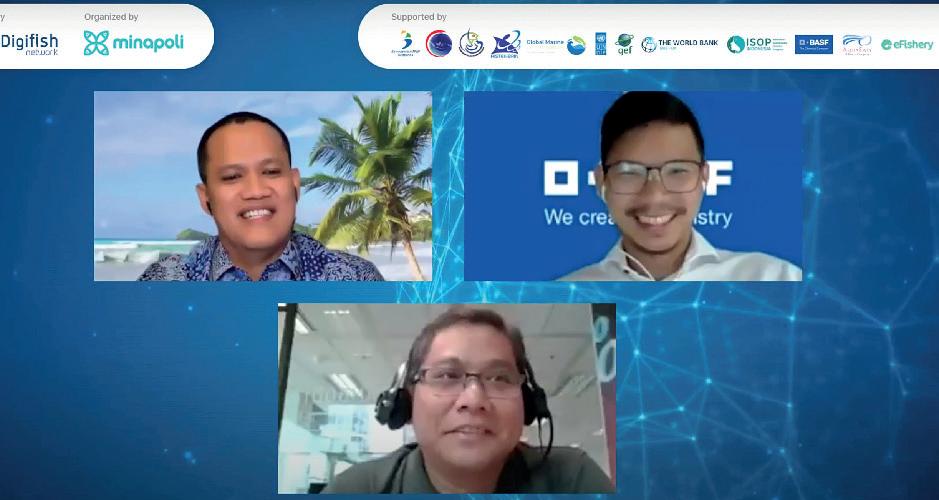
The strategy in Indonesia is to ensure that the economy moves from one which is based on its resources to one based on innovations and digitalisation to drive fisheries and aquaculture production. For breakthroughs in innovations, there should be a good research ecosystem with synergy and participation among academics, government and industry. The first startup in Indonesia’s aquaculture, eFishery Rully Setya Purnama, CEO Minapoli with presenters, Agus Ciputra (BASF Indonesia) began in 2013. Today, there are and Aries Fajar Dwiputera (Bosch Aquaculture). more than 30 startups in the fisheries and aquaculture sectors and more than 700 people involved with startups. Leading startups include Aruna Marketplace Targets for a digital economy (a digital fish auction platform, as well as marketplace for The Ministry of Marine Affairs and Fisheries (MMAF) has seafood products), eFishery and JALA. ambitious targets for 2024, and among them is to increase shrimp production by 250%. There is also a target to be one In 2018, Minapoli, which is itself a startup created in 2018 of the leading seafood producers globally. MMAF wants and led by CEO Rully Setya Purnama began organising to increase per capita fish consumption in Indonesia from Digifish. Following this, the Digifish Network of startups 58.3kg in 2020 to 60.9kg by 2024. In 2020, Indonesia’s was created. Since then, there is this annual gathering of seafood exports contributed USD6.1 billion and MMAF startups in Indonesia. The vision of the Digifish Network wants to increase this to USD8.2 billion in 2024, with a is to propel fisheries and aquaculture in Indonesia focus on the shrimp and tuna sectors. In 2020, (January with innovations and digitalisation. Discussions at this to September), shrimp exports led at 19.36% in terms of year’s Digifish included the impact of these startups on volumes and 39.78% in terms of value at USD1.49 billion. Indonesia’s aquaculture and fishery businesses during this very challenging pandemic year, and on its resilience and sustainability. Demands of export markets Budhi Wibowo, Head of the Seafood Products Processing Digifish 2020 was held virtually on December 15-16, with the theme “Accelerating the impact of innovation ecosystem on the fisheries sector”. It was attended by more than 450 participants; among them, were fish and shrimp farmers, startups/ innovators, government institutions, fisheries and aquaculture businesses, universities, NGOs and fisheries associations. There was a startup carnival with presentations from eight startups describing their innovations and achievements to date. A new session - a farmers’ showcase, presented innovations that farmers have adopted. Rully introduced two German companies with innovations targeted at shrimp aquaculture in Indonesia. Below are excerpts from some presentations and Marketing Association (AP5I) discussed collaboration, and upstream and downstream digitalisation to support seafood marketing. Budhi said that food safety, traceability and sustainability are crucial demands on Indonesia’s exports. “We need to have certification. Certifications such as BRC, BAP, GlobalGAP, ASC are required at B2B; this is the responsibility of the producer.” But he added that this is not all, as there is certification required at the country level before certification at the consumer level. Upstream there is food safety which means that shrimp ponds, suppliers and fishing vessels need to be certified. “As these are requirements at the country level, the government must fulfill them. If we do not, we cannot export to some countries or if we do so, the risks are high”. and brief profiles of some startups making waves in 2020. Traceability requirements by buyers include catch certificates by the EU (European Union); traceability data are required by Chinese buyers and USA buyers ask for In April 2020, with the Ministry of Marine Seafood Import Monitoring Program (SIMP) since 2019. This enhanced traceability is a major requirement which Affairs and Fisheries, Indonesian producers must follow. Traceability requires the Digifish Network data and this is where support with digitalisation and firm initiated a movement cooperation among stakeholders are essential.“makanikanitusehat” (eating fish is healthy) to provide access to quality seafood by “buying from Sectorial effect of the pandemic home”. Lelly Hasni from the Ministry of National Development said that the adverse Covid-19 effects include poor demand, market disruptions and poor prices. There was an urgent need to hasten digitalisation to help industry
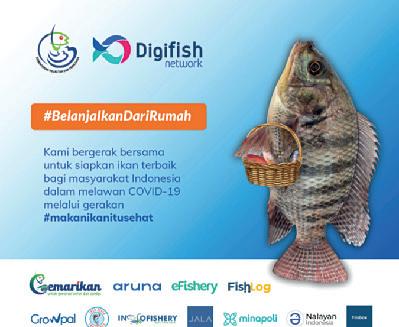
players market products. Innovation is also essential to pull investments into the sector. In terms of numbers, Budhi said that in 2020, the food service sector (hotels, restaurants, cafes, catering) fell by 80% but today, this has improved to the 60% level. The retail segment including supermarkets and online sales grew by 30%. The demand for ready-to-eat and value-added products rose very quickly. AP5I promoted the switch from food service to retail, especially for ready-to-cook and value- added products.
The discussion was also on upgrading marketing in local markets. According to Budhi, other than increasing the number of cooked and ready-to-eat products, reduction in the number of steps in the supply chain and upgrading in ecommerce are important targets. A major bottleneck is cold chain logistics, especially in cities with small market demand. He wants to see the distribution network shortened: from processing plants to distributors, frozen marts (offline/online) and finally the consumer. Currently distribution starts from processing plants to distributors, wholesalers, small retailers and consumers.
However, the frozen mart will need to have freezer facilities, with promotions online and collaboration with delivery partners such as Gojek and Grab. “We want to have frozen marts in as many areas as possible, with participation of small cooperatives. We need multistakeholder collaborations to increase seafood sales in domestic markets via digital platforms (Lazada etc.) for door-to-door distribution from producers to frozen marts, resellers and logistics,” said Budhi. “We need to effectively link buyers and producers. If we have better collaboration with producers, marketing is made easier.”
The Digifish Network initiated a movement “makanikanitusehat” (eating fish is healthy) to provide access to quality seafood by “buying from home”. It opened centres in 10 major cities. Sfari Burhanuddin, Deputy Minister at the Coordinating Ministry for Maritime Affairs and Investment emphasised on the mission to make local consumers proud of locally caught and farmed seafood with calls to consume local seafood.
Renewable energy in shrimp farming
According to Agus Ciputra, President of BASF Indonesia, among the current challenges in the shrimp sector is the intensive 24/7 use of energy. Electricity from the power grid can be costly and limited in accessibility. The use of renewable energy may address this challenge which can also address the sustainability element for the industry in Indonesia. Market access is limited, with 90% exported to the US. Access to the EU markets requires a focus on sustainability; ecological and social.

BASF New Business focuses on Aquaculture Solutions AQS – innovations to sustainably electrify Indonesia’s shrimp sector. “Our Blue revolution 4.0 hypothesis is that technology exists, but it is not yet available broadly. When used, we see the aquaculture sector in Indonesia moving towards higher productivity, greater efficiency, better sustainability and with higher value products,” said Agus. The components are clean energy, digital enablers and automation, disease control and asset financing by partners. Financing has been hard to come by mainly because of sustainability challenges. “The flagship is clean energy from photovoltaic power which costs USD0.05/KWh and is available 24/7,” added Agus. This is in comparison to diesel fuel at USD0.35/KWh, which is dependent on oil subsidies, and the grid which cost USD0.07/KWh. However, Agus said that this is key to unlock sustainability and green financing. BASF will work with financing partners and qualified technology providers with automation and digital tools to drive better control of farming, higher biomass with precision feeding and disease control to increase survival rates, reduce costs and risks.
Innovators and startups
AquaEasy Founder Aries Fajar Dwiputera presented its features. This innovation from Bosch Aquaculture has sensors which captures physical and biochemical parameters and AI (artificial intelligence) turns data into decisions and stores them in the cloud for easy accessibility and presents solutions to the farmers. These innovations help to overcome bottlenecks in the industry today comprising shrimp health and disease, maintaining optimal water quality, and recording accurate data. AquaEasy provides daily analysis and recommendations on farm data.
eFishery is the pioneering startup in Indonesian aquaculture; it has its beginnings in Bandung in 2013 with a fish demand feeder which with AI, developed into smart feeding devices for fish and shrimp farming. It has been steadily moving ahead and in 2020, achieved Series B funding led by Go-Ventures and Northstar, participation of AquaSpark and Wavemaker Partners. CEO, Gibran Huzaifah gave some insights on the progress to date. In January 2020, Gibran introduced eFisheryFund. Next came the eFisheryFresh, an on-demand marketplace.
A significant contribution during the pandemic was the action taken to help freshwater fish farmers with problems selling their harvests of live fish. “In April 2020, we took 850 tonnes of the unsold freshwater fish and kept them in cold storage. Working with a partner organisation, we donated the fish to Covid-19 frontliners in Indonesia.”
Established in 2015, JALA is pushing for data driven shrimp farming in Indonesia. Liris Maduningtyas, CEO listed the challenges in shrimp farming: at preproduction with financing and fintech, at production with
Moderator Luky Adrianto, Dean of Faculty of Fisheries & Marine Sciences, IPB University (left) with speakers, clockwise; eFishery CEO, Gibran Huzaifah (centre); David Kaczan, World Bank; Budhi Wibowo, AP5I and Dr Agus Somamihardja.
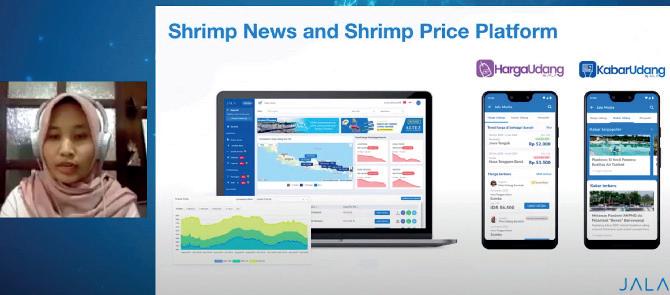
manually monitoring pond conditions, crop failures, diseases etc, and postproduction with the effects of higher demand than supply, market access and incomplete traceability records. Liris said that as of November 2020, JALA’s technology is being used by 14,500 ponds from almost 900 ponds at the end of 2018. In terms of users, there are more than 7,800. It has more than 20 partners and more than 40 B2B clients, local and international in Malaysia, Thailand, Vietnam and China. To date, JALA has raised seed funding from 500 Startups, Hatch, and Conservation International Ventures.
The two-year old startup, Banoo has created an affordable technology to improve water quality. This is a system which floats on the water with a microbubble generator and linked to an IoT sensor which turns the generator on/off based on the dissolved oxygen level to improve energy efficiency. Sgara has recently launched its Sgara Book in 2020 to improve farmers productivity through data integration, information on water quality, shrimp growth, feeds, chemical use and probiotics combined with feed tray and shrimp disease monitoring, stock and harvests (see article in Aqua Culture Asia Pacific September/ October 2020).
FisTx, a research-based platform provides technology and data driven holistic solutions. Yogi Ariadenta, Head of Business Development said that FisTx is looking at the democratisation of aquaculture: aquaculture for everybody and anywhere. It has the Oasse ponds, a round tank system, which can be easily dismantled and moved, and are suitable as nursery or culture ponds for high density stocking. There is the low cost, easy to use water quality test kits connected to its multifunction app for data input. Results are given in less than 5 minutes and accuracy is 85%. Its four products are now used by farmers in 25 locations, mainly on Java Island.
Minapoli, a startup for information and business in fisheries and aquaculture, strives for a stronger synergy among stakeholders and wishes to integrate all segments in Indonesia’s fisheries and aquaculture to contribute to its development. “Minapoli is the first marketplace
Azellia Alma Shafira, CEO of Banoo described the work so far with its microbubble generator and linked to an IoT sensor to improve water quality, particularly for small farmers. Banoo showed a proven 40% increase in productivity. Liris Maduningtyas, CEO introduced the latest from JALA, a shrimp trading platform.
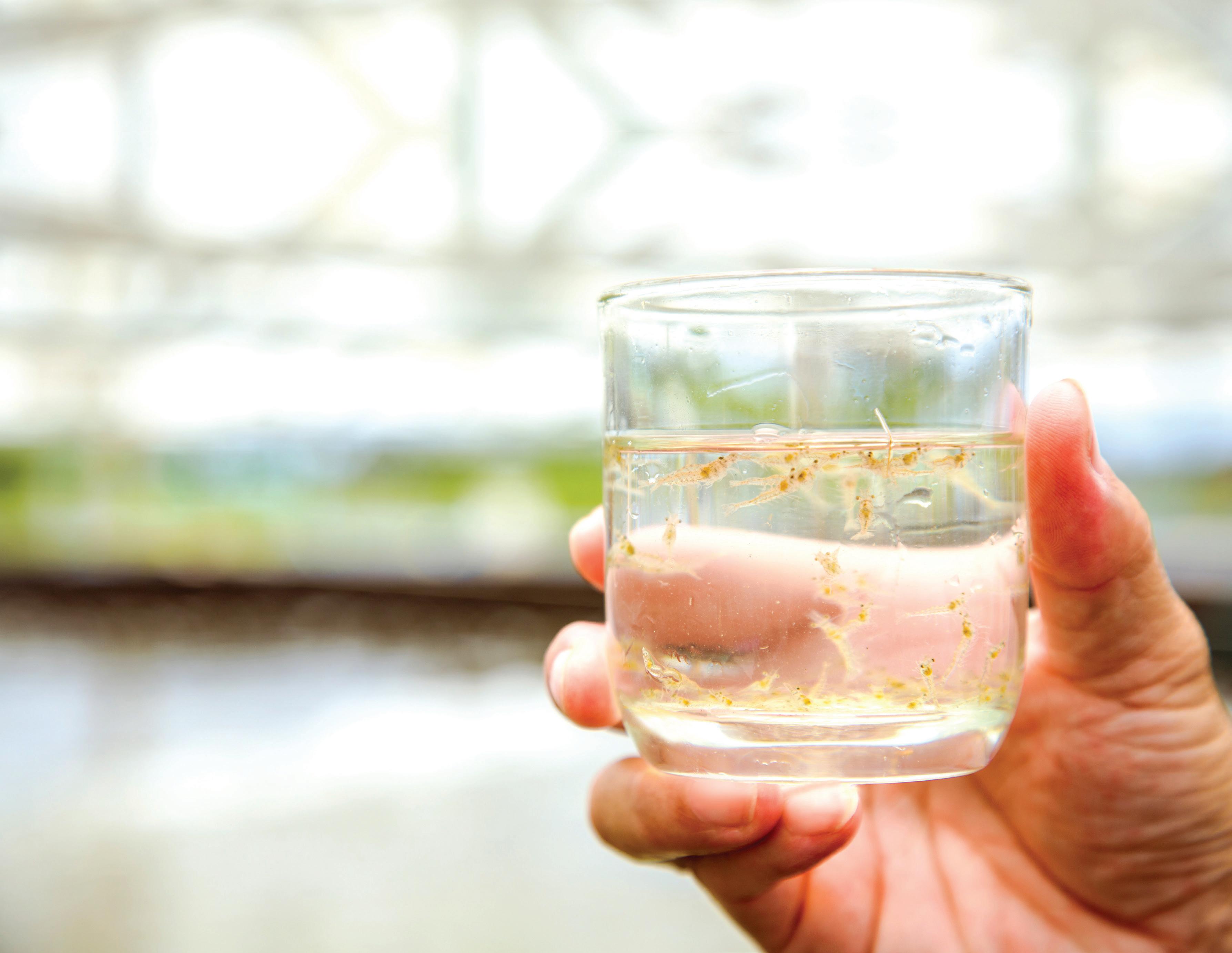
for aquaculture; currently it has 36 product categories, essential for shrimp and fish farming. It works with suppliers to offer products at competitive prices. Over the past 10 months in 2020 from January to October, monthly visitors grew 714% at 27,000,” said Rully. The coverage is over 47 cities in 18 provinces. It has more than 60 partners, many of them leading companies involved in aquaculture in Asia. “Beginning with Indonesia, we plan to be the leading aquaculture network in the Asia Pacific region.”
According to Achmad Jerry, Venambak fosters small scale farmers to be partners in the setup of mini recirculating aquaculture systems (RAS) for intensive shrimp farming in urban locations. It will assist in operations: before production, during production and post harvest. The daily challenges are in three areas: water quality management, energy for aeration and other activities, and waste management. Venambak has a hybrid ammonia reducer that requires less energy, produces less wastes and is accessible to smallholder farmers. It has trials in a RAS in Sidoarjo, Java, stocking 300-800 post larvae (PL)/m3 in cooperation with Solidaridad Indonesia and with support from the Walton Foundation.
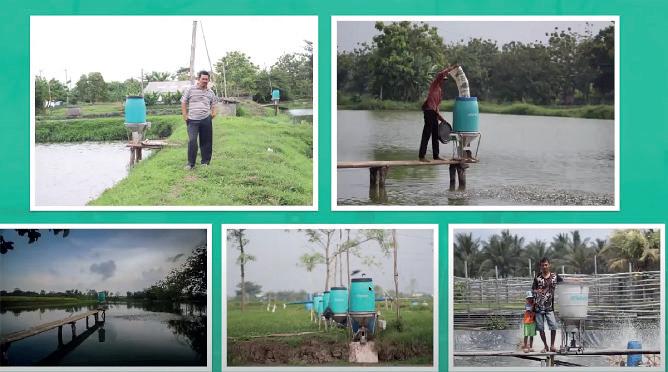
eFishery’s smart feeders are being used in 23 provinces.
2021
April 14-16
VietShrimp Aquaculture International Fair Cantho City, Vietnam
https://vietshrimp.net
April 13-15 (online)
Aquaculture Europe (AE2020 Cork)
https://aquaeas.eu/
August 18-19
TARS 2021: Shrimp Aquaculture Ho Chi Minh City, Vietnam
www.tarsaquaculture.com
August 23-26
11th Symposium on Diseases in Asian Aquaculture (DAA11) Kuching, Malaysia
www.daa11.org
August 25-27
Vietfish 2021 Ho Chi Minh City
www.vietfish.com.vn
September 14
SPACE 2021 DIGITAL
www.space.fr
September 22-24
VIV Asia Bangkok, Thailand
www.viv.net
October 4-7
Aquaculture Europe (AE2021) Madeira, Portugal
www.aquaeas.org

